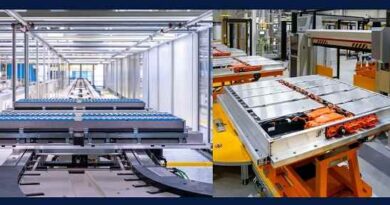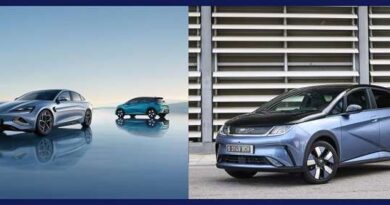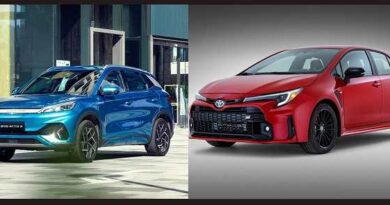Tesla Unveils the Cybercab: A Bold Leap into Autonomous Driving, Coming in 2026 at $30,000
Tesla has once again pushed the boundaries of innovation, this time by revealing the highly anticipated Cybercab.
Tesla has once again pushed the boundaries of innovation, this time by revealing the highly anticipated Cybercab, an autonomous, steering-wheel-less robotaxi. Set to hit the market between 2026 and 2027, the Cybercab promises to revolutionize the transportation industry with its groundbreaking features and affordable price tag. But is Tesla’s bold vision feasible? Let’s take a closer look at what the Cybercab offers and how it compares to Tesla’s past promises.

What is the Cybercab?
Tesla’s Cybercab is a fully autonomous electric vehicle that represents the company’s most significant innovation in the past five years. Following in the footsteps of Tesla’s iconic Model 3 and Model Y, the Cybercab aims to democratize autonomous driving in the same way those vehicles brought electric cars to the mainstream. This two-seater robotaxi will debut with a stunning starting price of less than $30,000, made possible through Tesla’s third-generation platform, which drastically cuts costs compared to its older architectures.
At first glance, the Cybercab is a head-turner. With its sleek, aerodynamic body and eye-catching butterfly doors, it certainly makes a visual statement. However, unlike the more radical design of Tesla’s Cybertruck, the Cybercab maintains a more refined look, though it still includes some design nods to its pickup truck sibling, such as the slim light strips that stretch across the front and rear.
But perhaps the most striking aspect of the Cybercab is what it doesn’t have: a steering wheel and pedals. Classified as a Level 5 autonomous vehicle, the Cybercab is designed to navigate city streets, highways, and everything in between without any human intervention. This is a bold leap toward a future where cars are fully self-driving, but can Tesla deliver on this promise?
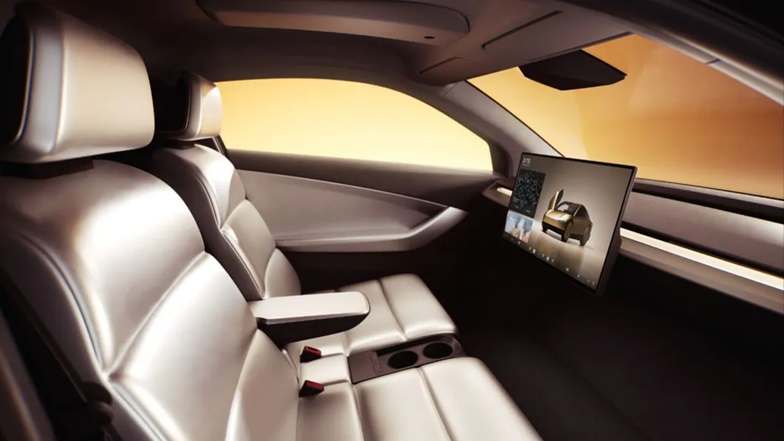
Key Features of the Cybercab
Tesla’s Cybercab boasts an array of futuristic features designed to make autonomous driving as seamless as possible. Here are some of the highlights:
- Affordability: With a price tag under $30,000, the Cybercab is poised to make autonomous driving accessible to more people than ever before.
- Design: The Cybercab’s butterfly doors and sleek exterior give it a modern, almost sci-fi look. It lacks a rear window but makes up for it with a massive tailgate.
- Level 5 Autonomy: No steering wheel, no pedals—this car is fully autonomous, making it capable of navigating any driving situation, whether on city streets or highways.
- Minimalist Interior: Inside, Tesla’s design philosophy of minimalism is taken to new heights. The cabin features a large horizontal touchscreen for infotainment, a wide air vent, two basic seats, an armrest, and cup holders—nothing more.
- Wireless Charging: Tesla has introduced wireless induction charging, allowing the Cybercab to autonomously recharge at compatible stations. Tesla also unveiled an automated cleaning system for the vehicle.
- Operating Costs: The estimated cost of operation is a mere $0.20 per mile, making it an affordable option for everyday use.
- Car-Sharing Option: Private owners will be able to share their Cybercab through Tesla’s car-sharing network, dubbed the Tesla Network.
These features position the Cybercab as a game-changer in the autonomous vehicle space, but it’s not without its skeptics.
Elon Musk’s Ambitious Timeline: Realistic or Wishful Thinking?
While Tesla CEO Elon Musk is confident that the Cybercab will hit the market by 2026 or 2027, there’s reason to be cautious. Musk has been promising fully autonomous driving for years—since 2016, in fact—but Tesla’s Full Self-Driving (FSD) system is still not at the level of full autonomy that Musk has claimed would be “just around the corner.”
Analysts have expressed skepticism about Tesla’s ability to meet this timeline, especially given the company’s history of delayed launches. For example, the much-hyped Cybertruck, announced in 2019, still hasn’t entered full production as of late 2024. And while Tesla has made strides in its self-driving technology, the company’s FSD system remains a work in progress.
This uncertainty leaves many wondering whether Tesla will be able to pull off its most ambitious project yet: a mass-market autonomous vehicle that’s not only affordable but also truly capable of navigating the complexities of the real world without human input.

Tesla’s Past Promises vs. the Reality
| Tesla’s Promise | Reality |
|---|---|
| Full autonomy by 2018 | FSD still in beta, far from Level 5 |
| Cybertruck in 2021 | Delayed to at least 2025 |
| Affordable robotaxis by 2026 | Analysts remain skeptical |
| $30,000 starting price for Cybercab | Achievable, but will autonomy meet expectations? |
The Bigger Picture: Tesla’s Vision for the Future
Despite these doubts, the potential impact of the Cybercab cannot be ignored. If Tesla can deliver, the Cybercab could mark the beginning of a new era in transportation. With a price point that makes it accessible to a wide audience and the promise of fully autonomous driving, it could revolutionize how we think about car ownership and commuting.
Tesla also envisions the Cybercab as a pivotal part of its Tesla Network, a car-sharing platform that allows owners to rent out their vehicles when not in use. This would effectively turn every Cybercab into a money-making machine for its owners, much like how Airbnb revolutionized short-term property rentals.
Moreover, the vehicle’s wireless charging and automated cleaning systems further enhance its futuristic appeal. These features suggest a world where autonomous vehicles operate with minimal human intervention, charging themselves and keeping themselves clean while you focus on other things.
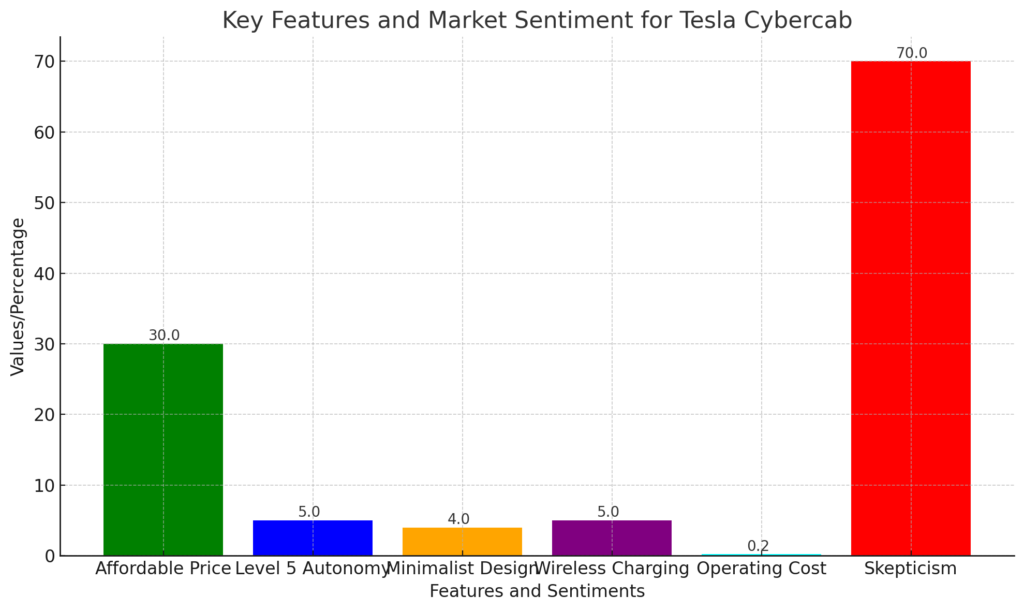
Here is the bar graph representing key features and market sentiment for the Tesla Cybercab. It highlights important aspects like the affordable price, level 5 autonomy, minimalist design, wireless charging, low operating cost, and skepticism surrounding the release dates
A Game-Changer or a Pipe Dream?
The Tesla Cybercab is undeniably an exciting concept, one that could reshape the transportation landscape. With its bold design, affordable price, and promises of full autonomy, it’s easy to see why there’s so much buzz around its release. However, given Tesla’s track record of delayed launches and unmet promises, it’s important to temper expectations.
If the Cybercab does hit the market on time and delivers on its promises, it could democratize autonomous driving in a way we’ve never seen before. But if history is any indication, we may be waiting longer than 2026 to see Tesla’s robotaxi dreams become a reality. Either way, the Cybercab is a bold step toward a future where cars drive themselves, and that future might just be closer than we think—if Tesla can pull it off.
Related Post

